Hydrochar, a solid residue generated from the hydrothermal liquefaction (HTL), presents both challenges and opportunities in biomass valorization. While HTL is a competitive technology aimed at producing crude bio-oil, the major limiting its economic viability and technical scalability is the safe disposal of generated by-products, which include nearly 25 wt% to 50 wt% post-hydrothermal aqueous phase (HTL-AP) and 5 wt% to 20 wt% solid hydrochar residues. Existing HTL studies have extensively characterized crude bio-oils, but hydrochar has received less attention, primarily focusing on yield and ultimate analysis.
Hydrochars (HCs), produced from HTL with carbon as the main component, can serve as low-cost adsorbents. However, their porosity and BET surface area remain relatively low due to the formation and condensation of hydrocarbons on the surface, which clogs pores. To improve this, chemical activation can be employed, where HCs are impregnated with agents acting as oxidants and then pyrolyzed. This process aromatizes the HCs carbon skeleton, introduces oxygen-containing functional groups, and develops a porous structure.
𝐒𝐭𝐞𝐩 1: 𝐅𝐫𝐨𝐦 𝐖𝐡𝐞𝐚𝐭 𝐒𝐭𝐞𝐦 𝐭𝐨 𝐇𝐲𝐝𝐫𝐨𝐜𝐡𝐚𝐫𝐬 𝐯𝐢𝐚 𝐇𝐓𝐋
Wheat stems (WS) were subjected to HTL, transforming into HCs. Scanning electron microscopy (𝘚𝘌𝘔 𝘪𝘮𝘢𝘨𝘦𝘴 👇) reveals changes in the dense structure of WS, attributed to its carbohydrate composition. This transformation creates mesoporous cavities (Dp of 12.79 to 33.58 nm) and results in low BET surface areas (5.46–26.06 m²/g).
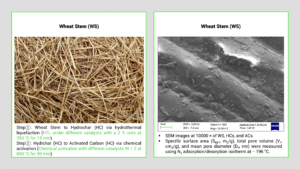
𝐒𝐭𝐞𝐩 2: 𝐅𝐫𝐨𝐦 𝐇𝐲𝐝𝐫𝐨𝐜𝐡𝐚𝐫𝐬 𝐭𝐨 Activated Carbons (𝐀𝐂𝐬) 𝐯𝐢𝐚 𝐂𝐡𝐞𝐦𝐢𝐜𝐚𝐥 𝐀𝐜𝐭𝐢𝐯𝐚𝐭𝐢𝐨𝐧
Through activation, the porous structure and adsorption capacity of HCs were enhanced. This process widens existing pores and introduces new pores (1.75 to 6.61 nm), resulting in ACs with BET surface areas 100.22–1612.04 m²/g. The transformation occurs through reactions between activating agents and the carbon structure in HCs at 800 °C, which leads to carbon weight loss and yields decrease from 14.49% to 38.07%.
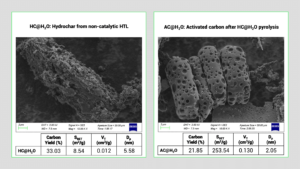
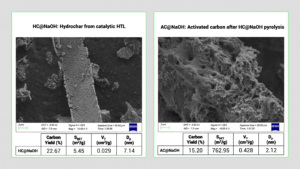
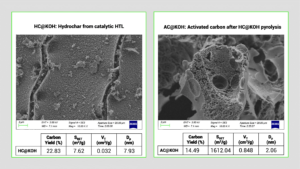
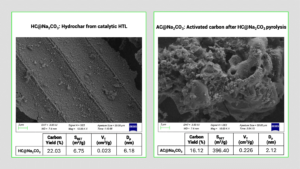
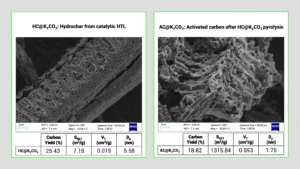


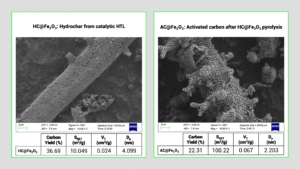
Integrating activated hydrochars as an alternative and low-cost adsorbents holds great promise for effectively removing organic and nutrient compounds from HTL-AP. Our research article titled “𝘉𝘪𝘰-𝘤𝘳𝘶𝘥𝘦 𝘖𝘪𝘭𝘴 𝘗𝘳𝘰𝘥𝘶𝘤𝘵𝘪𝘰𝘯 𝘧𝘳𝘰𝘮 𝘞𝘩𝘦𝘢𝘵 𝘚𝘵𝘦𝘮 𝘶𝘯𝘥𝘦𝘳 𝘚𝘶𝘣𝘤𝘳𝘪𝘵𝘪𝘤𝘢𝘭 𝘞𝘢𝘵𝘦𝘳 𝘊𝘰𝘯𝘥𝘪𝘵𝘪𝘰𝘯𝘴 𝘢𝘯𝘥 𝘉𝘢𝘵𝘤𝘩 𝘈𝘥𝘴𝘰𝘳𝘱𝘵𝘪𝘰𝘯 𝘰𝘧 𝘗𝘰𝘴𝘵-𝘏𝘺𝘥𝘳𝘰𝘵𝘩𝘦𝘳𝘮𝘢𝘭 𝘓𝘪𝘲𝘶𝘦𝘧𝘢𝘤𝘵𝘪𝘰𝘯 𝘈𝘲𝘶𝘦𝘰𝘶𝘴 𝘗𝘩𝘢𝘴𝘦 𝘰𝘯𝘵𝘰 𝘈𝘤𝘵𝘪𝘷𝘢𝘵𝘦𝘥 𝘏𝘺𝘥𝘳𝘰𝘤𝘩𝘢𝘳𝘴” published in the Chemical Engineering Journal (CEJ) Engineering Journal, delves into this potential.
🔗 Check out for more data: https://lnkd.in/dKtuhyPU.

 All Resources
All Resources 

